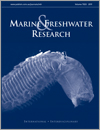Marine and Freshwater Research
Volume 70
Number 3 2019
Polychaete worms were characterised from four surveys of the Oceanic Shoals marine park region and related to other biological and environmental variables. The results showed that assemblages differed among all surveys, even those of the same location. No strong relationships with environmental variables were observed. Management implications are discussed, particularly in relation to banks and shoals as key ecological features.
The status of plants as indicators of a wetland can enable more accurate mapping and provide a tool for on-ground validation of wetland boundaries. This paper developed a wetland plant indicator list for the Lachlan River catchment through expert elicitation, and compared this list with water plant functional groups and Queensland’s flora wetland indicator species list.
We studied the effect of the Lakshadweep Low (LL) on the zooplankton community of the Arabian Sea. The LL, characterised by low sea surface height and originating around the vicinity of the Lakshadweep islands during the mid-summer monsoon, is unique to the Arabian Sea. The LL played an important role in enhancing the biomass and abundance of zooplankton in this region.
We used years- and decades-old dry white abalone shells to obtain mitochondrial and nuclear DNA. Decontamination experiments showed shell as the source. Haliotis sorenseni populations were genetically impoverished at the cytochrome c oxidase subunit I (COI) gene before the recent fishery-related population crash, reflecting a demographic history different than regional congeners. Shell DNA retrieval depended on primer specificity more than on shell characteristics and has potential for broad application.
Physical classification systems are often used to guide the design of environmental monitoring programs in estuaries, but how well do they represent the biota that live within? We investigated the effectiveness of one classification scheme on macrofaunal communities and discovered that differences across two common estuarine types are dependent on the location of sampling. Classification based on physical characteristics alone does have potential, but only if the biological scales of variability within these systems are well understood.
Bacalar Lagoon is a shallow, oligotrophic system with a mineralogical composition dominated by calcite. Water column and sediment geochemical analyses show clear spatial distribution of different parameters. Herein we present the first measurements of trace element (Ba2+, Mn2+, K+, Ni2+, Zn2+) concentrations in carbonates from sediments. No trace element contamination was identified, and only Zn2+ seem to have a predominantly anthropogenic origin.
Local environmental variables and land use changes can play important roles in driving tadpoles’ microhabitat choice and morphological adaptations. Increases are seen in the body size and tail length of tadpoles in smaller ponds, as well as in ponds surrounded by vegetation changes from forest to pasture or short crops. Moreover, an interaction was found between the size of the tail, as well as between deviations in the position of the eye, nostril and mouth of tadpoles and the heterogeneity of vegetation around ponds.
We investigated changes in trophic relationships of fish communities from river to the ocean. The findings revealed that fishes relied on distinct primary producers and prey to obtain their nutrition along this transect, with a higher degree of trophic interactions in the transition zone (estuary). This knowledge is useful to mitigate climate change effects on biological communities at coastal zones.
Overall, this study showed that morphological characteristics would be useful to distinguish Sthenoteuthis oualaniensis population structure. However, because squid beak morphology might correlate with their high life-history plasticity, potential results could be considered misleading when using this trait to determine populations in future. Future research needs to be done on morphology combined with genetic evaluation to compare methods of geographic and intraspecific population identification.
There is a clear temporal variation and spatial distribution in terms of the composition and abundance of plankton ciliate species in Shen’ao Bay, South China Sea. Ciliate communities were correlated with environmental conditions (e.g. temperature, chlorophyll-a, nutrient levels) and some ciliate species, especially the dominant species, can be considered as potential bioindicators to reflect their aquatic habitat and environmental stress.
This study provides a direct comparison of the metabolic rates and swimming kinematics of lemon sharks measured in two different types of respirometry system: a flume and an annular static respirometer. Both metabolic rates and kinematic relationships differed between the two systems, highlighting the need for caution when drawing physiological comparisons from measurements made in different systems, or when applying respirometry results to wild fish and elasmobranchs.
Pumping of water from hinterland drainage systems into the main river poses a health risk to fish. This study investigated the effects of pump passage on fish health, injury intensity and mortality. Immediate mortality and injury intensity increased with revolutions per minute (rpm). As a measure to reduce health risks for fish, the pumps should run at low rpm as often as possible.





